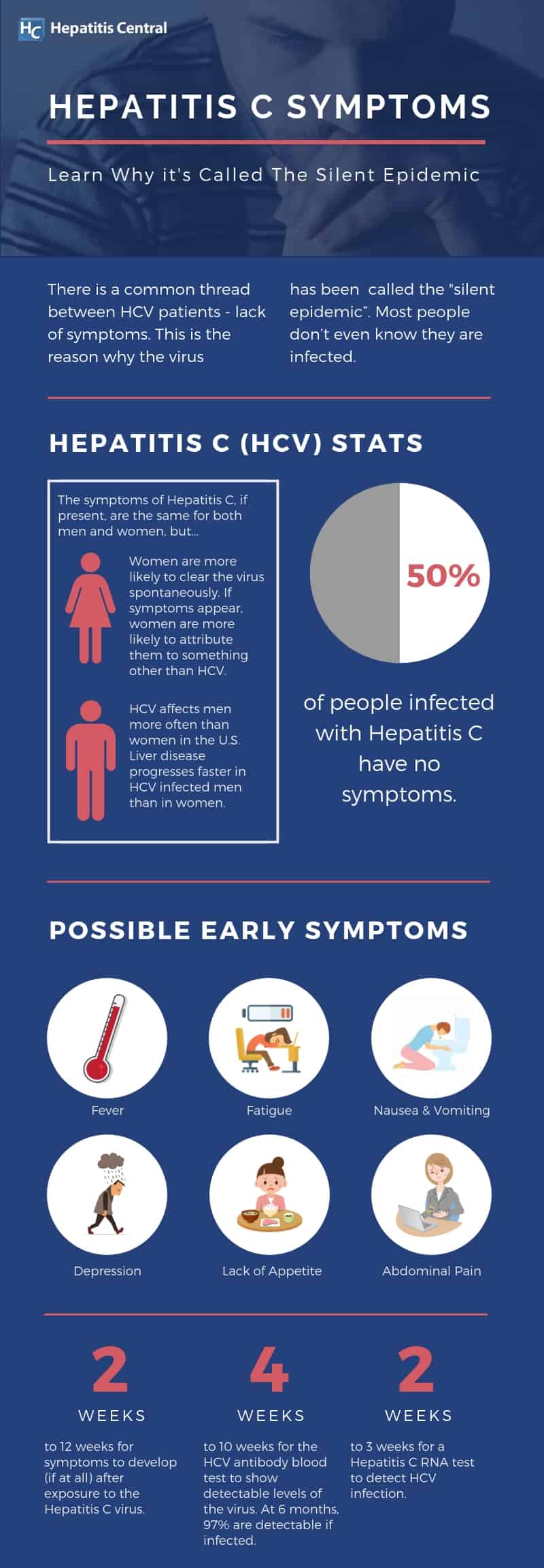Hepatitis C Symptoms
The Silent Epidemic
There is a common thread between Hepatitis C patients and the reason why the virus has been called the “silent epidemic”: most people who have the virus don’t even know they are infected. The Centers for Disease Control and Prevention (CDC) say that this is the case for at least 50% of those infected with Hepatitis C. It is a sneaky virus and most people don’t know they have it.
HCV Transmission
The Hepatitis C virus is usually spread when the blood from an infected person enters the body of someone who isn’t infected. Nowadays, most people are infected with Hepatitis C through sharing needles or other equipment to prepare or inject drugs. However, before 1992, Hepatitis C was also commonly spread through blood transfusions and organ transplants, as screening for the virus had not yet been implemented.
Often, people are concerned about how Hepatitis C could be transmitted to them once they find out someone they know is infected.
It is important to know that Hepatitis C is not spread through such activities as:

- hugging
- sharing eating utensils
- breastfeeding
- holding hands
- coughing
- sneezing
While Hepatitis C can be spread through sexual contact, the risk of transmission is believed to be low. One’s risk of getting infected or transmitting the Hepatitis C virus will increase through sexual contact if you have multiple partners, have another sexually transmitted disease, or are HIV positive.
For more information about the transmission of Hepatitis C, we recommend visiting the CDC’s website where you can review common questions regarding transmission as well as see who is at risk for Hepatitis C.
It is simply impossible for you to diagnose Hepatitis C by yourself. Since most patients infected with the Hepatitis C virus have no signs or symptoms, it would be nearly impossible to know if you have the virus. If you notice symptoms or if you’re at risk for Hepatitis C, speak to your doctor.
The Development of Hepatitis C Symptoms
If a person becomes infected, it is possible that it can take 2 to 12 weeks for symptoms to develop from an acute (new) infection. However, most people with chronic Hepatitis C don’t notice any symptoms at all. In some cases, a person might feel fatigued or depressed but don’t attribute these things to being infecting with Hepatitis C.
How long after exposure to Hep C does it take to show up in a blood test?

If you think you have been exposed to the Hepatitis C virus, the HCV antibody blood test may show detectable levels of the virus as early as 4-10 weeks after exposure. By waiting longer after exposure – about six months – it is determined that about 97% of people should have detectable antibodies with an HCV antibody test if they have in fact become infected.
With a Hepatitis C RNA test, a person can tell if they are infected just 2 to 3 weeks after exposure.

People at the Highest Risk of Having HCV
When you think you may have been exposed to Hepatitis C, it is excruciating to think that you would have to wait weeks just to be tested to see if you are infected. Often, people will look to see if they have any symptoms to help determine if they are infected or ease their minds.
Keep in mind that in order to transmit the Hepatitis C virus, the blood of an infected individual would have to enter your body. If there hasn’t been a transfer of blood, your chances of infection are very low.
It is important to know that the CDC states those that are at the highest risk of having Hepatitis C include:

- Current or former injection drug users, including those who injected only once many years ago
- Those born between 1945 and 1965
- Recipients of clotting factor concentrates made before 1987, when less advanced methods for manufacturing those products were used
- Recipients of blood transfusions or solid organ transplants prior to July 1992, before better testing of blood donors became available
- Hemodialysis patients
- People with known exposures to the Hepatitis C virus, such as:
-
- Health care workers exposed to needle sticks involving blood from someone who is infected with the Hepatitis C virus
- Recipients of blood or organs from a donor who tested positive for the Hepatitis C virus
- People who are HIV positive
- Children born to mothers infected with the Hepatitis C virus (about 6% of infants born to mothers with Hepatitis C become infected)
- People who are incarcerated
- People who use intranasal drugs
- People who received body piercing or tattoos done with non-sterile instruments
What Are the Early Symptoms of Hepatitis C?
Again, people who have a new (acute) Hepatitis C infection usually don’t have symptoms. If they do they are often mild and may be attributed to something else such as a cold or the flu.
When symptoms do occur, they may include:

- Fever – An elevated body temperature higher than 100° F (37.8° C)
- Fatigue – This is not simply just feeling tired from time to time. Fatigue is an unrelenting exhaustion that develops over time, lasts longer, reduces your energy, motivation and concentration and isn’t relieved by rest.
- Depression
- Abdominal pain – Some patients with Hepatitis C report discomfort in the abdomen or in the area of the liver which can be. This can take the form of either dull or sharp pain that may come and go or be persistent.
- Loss of appetite
- Weight loss
- Nausea – That feeling of being sick to your stomach
- Vomiting
- Joint pain – In some cases, patients with Hepatitis C may experience sore joints, often in the hands, ankles or wrists and occasionally in other areas, caused by the production of cryoglobulins.
Chronic Hepatitis C Symptoms
In long-term (chronic) Hepatitis C infection, the liver can become more damaged and subsequently decrease in function. There are often still a lack of symptoms, but for some, symptoms can surface or existing ones can become worse.
New or worsening symptoms may include:

- Brain fog – Mental confusion or lack of mental clarity. This can be best described as feeling spacey, forgetful, lost and fatigued.
- Bleeding easily
- Bruising easily
- Dark colored urine – The typical color of urine is straw-yellow. Dark brown or orange-colored, clear urine can be a sign of a liver disorder caused by excess bilirubin.
- Stool that is pale, clay (light gray) or putty-colored – Bile salts released by the liver give stool its normal brown color. If bile production or flow of bile out of the liver is compromised, it can cause this discoloration of your stool.
- Jaundice – The yellowing of the skin and whites of the eyes caused by high bilirubin levels.
- Pruritis (itchy skin) – It is estimated that up to 20% of chronic Hepatitis C patients experience itchy skin. Experts believe pruritus in people with liver disease is due to the accumulation of poisons that have not been effectively filtered by a damaged liver. When liver damage impedes the flow of bile through the liver, bile acids and bilirubin get backed up in the blood. High bilirubin levels often cause pruritus.
- Urticaria – This effects the skin and presents as a red, itchy rash that can appear in numerous places on the body and can lead to swelling.
- Lichen planus – A white patchy or scaly rash that can be found in various places on the body including the scalp, mouth, nails and genitalia.
- Ascites – The presence of excess fluid in the peritoneal cavity, which is the space between the abdominal organs and the skin. As a result of this fluid buildup, the abdomen swells and distends. While cirrhosis is the most common cause of ascites, it can also have other causes such as cancers, congestive heart failure of kidney failure. Ascites is usually a sign of severe liver disease and must be clearly distinguished from other reasons for abdominal distention.
- Swelling in the legs
- Spider angiomas – Small, spider-like capillaries that are visible just underneath the surface of the skin.
- Peripheral neuropathy – Numbness, pain, tingling in the hands or feet
Symptoms of Hepatitis C for Men and Women
Both men and women can become infected with Hepatitis C, although the virus affects men in the United States more often than women. Also, women are more likely to clear the virus spontaneously than men.
The symptoms of Hepatitis C, if present, are the same for both men and women; however, women who do experience symptoms may ignore them thinking that they are caused by something else such as anemia or menopause.
Liver disease progresses more slowly for women with Hepatitis C than for men, although the progression of liver disease changes as women age. Postmenopausal women having lost the protective effects of estrogen have increased rates of liver fibrosis over women still in their reproductive years.
While Hepatitis C can affect both men and women, women living with Hepatitis C have different issues to contend with than men.
Hepatitis C Complications
As the Hepatitis C infection continues over many years it can progress into additional liver complications.
Scarring of the liver, or cirrhosis, can develop in approximately 10-20% of patients having chronic Hepatitis C infection over 20-30 years. Developing cirrhosis is more common in men if you are 50 years or older, consume alcohol, have nonalcoholic fatty liver disease, Hepatitis B infection, HIV infection OR take immunosuppressive drugs.
Liver cancer is another complication of long-time hepatitis C infection. For those who have developed cirrhosis, only 1-5% of patients will develop liver cancer.
For patients who develop cirrhosis as a result of Hepatitis C infection, 3-6% will develop liver failure – the loss of liver function. For cirrhosis patients who develop liver failure, it usually means that their liver has been deteriorating gradually.
It is possible for Hepatitis C to go away without treatment; however, of all people who contract Hepatitis C, only fifteen percent or less will have a self-limited case in which their immune system defeats the virus. It has not been established exactly why this happens.
Individuals who have been diagnosed with chronic Hepatitis C can be treated with various combinations of medication. The type of treatment as well as the length of treatment for Hepatitis C depends on the genotype of the virus. Working closely with one’s physician and using an open line of communication will help in determining the best course of action.
For various medications used for the treatment of Hepatitis C, please visit our Medications to Treat Hepatitis C Timeline.
While medications are very expensive, there are much less costly liver supplements you can try to support your liver, including milk thistle.
Additional Reading:
- Chronic Hepatitis Symptoms
- Intractable Ascites
- Rheumatic Manifestations and Immunological Abnormalities
- Subclinical Hepatic Encephalopathy Impairs Daily Functioning
- Pruritis and the Hepatitis C Virus
- Pruritis in Chronic Hepatitis C (Itching)
- Ascites, Symptoms, Signs, and Diagnosis
“8 Early Symptoms: Could You Have Hepatitis C?” Hepatitis C, Albumin, What Is It, Current Information On Hepatitis C & Treatments for the Medical Professional and Patient. | Hepatitis Central, 1 Mar. 2016, www.hepatitiscentral.com/news/8-early-symptoms-could-you-have-hepatitis-c/.
Baden, Rachel, et al. “Natural History and Management of Hepatitis C: Does Sex Play a Role?” OUP Academic, Oxford University Press, 15 July 2014, academic.oup.com/jid/article/209/suppl_3/S81/2192774.
Cutler, Nicole. “The Connection Between Brain Fog and Liver Health.” LiverSupport.com, LiverSupport.com, 5 June 2012, www.liversupport.com/the-connection-between-brain-fog-and-liver-health/.
Davis, Charles Patrick. “Bilirubin Test: Normal & High Levels in Adults & Newborns.” Edited by Bhupinder S. Anand, MedicineNet, www.medicinenet.com/bilirubin_and_bilirubin_blood_test/article.htm.
Dharel, Narayan. “Cryoglobulinemia (Hepatitis C).” Cancer Therapy Advisor, 12 Dec. 2017, www.cancertherapyadvisor.com/hospital-medicine/cryoglobulinemia-hepatitis-c/article/604567/.
“Doctor Describes What Clay Colored Stools Look Like.” Scary Symptoms, 2 Mar. 2017, scarysymptoms.com/2015/07/doctor-describes-what-clay-colored/.
Hayes, Nikki. “Are You Part of the Silent Epidemic.” Centers for Disease Control and Prevention, Centers for Disease Control and Prevention, 7 Feb. 2018, https://blogs.cdc.gov/cancer/2018/02/05/silent-epidemic/.
“Hepatitis C.” Mayo Clinic, Mayo Foundation for Medical Education and Research, 6 Mar. 2018, www.mayoclinic.org/diseases-conditions/hepatitis-c/symptoms-causes/syc-20354278.
“Hepatitis C Questions and Answers for the Public.” Centers for Disease Control and Prevention, Centers for Disease Control and Prevention, 12 June 2018, www.cdc.gov/hepatitis/hcv/cfaq.htm.
“Hepatitis C Symptoms.” Hep, 19 Feb. 2018, www.hepmag.com/basics/hepatitis-c-basics/hepatitis-c-symptoms.
“Pain Associated with Hepatitis C.” AST (SGOT): Liver Function Test - Viral Hepatitis, 13 Feb. 2018, www.hepatitis.va.gov/patient/daily/pain/hepatitisC-pain.asp.
“A Painful Connection: HCV, Cryo, and Neuropathy.” Hepatitis C, Albumin, What Is It, Current Information On Hepatitis C & Treatments for the Medical Professional and Patient. | Hepatitis Central, www.hepatitiscentral.com/hepatitis-c/cryo/connection/.
Pierce, Jenelle Marie. “Hepatitis C Rash.” HepatitisC.net, 15 May 2016, hepatitisc.net/living/rash/.
Pierce, Jenelle Marie. “Hepatitis C Symptoms - Nausea.” HepatitisC.net, 9 Aug. 2017, hepatitisc.net/living/symptoms-nausea/.
Porter, Lucinda. “Hepatitis C and Skin Disorders.” Lucinda Porter, RN, 8 Oct. 2015, www.lucindaporterrn.com/hepatitis-c-and-skin-disorders/.
Porter, Lucinda K. “Women & Hepatitis C An HCSP Guide.” HCV Advocate, Mar. 2015, hcvadvocate.org/hepatitis/factsheets_pdf/women_guide.pdf
Women & Hepatitis C An HCSP Guide.
“The Progression of Liver Disease.” American Liver Foundation, liverfoundation.org/for-patients/about-the-liver/the-progression-of-liver-disease/.
“Stools - Pale or Clay-Colored: MedlinePlus Medical Encyclopedia.” MedlinePlus, U.S. National Library of Medicine, medlineplus.gov/ency/article/003129.htm.
“Symptoms: Fatigue.” Mayo Clinic, Mayo Foundation for Medical Education and Research, 11 Jan. 2018, www.mayoclinic.org/symptoms/fatigue/basics/definition/sym-20050894.
Tunkel, Allan R. “Fever in Adults - Infections - Merck Manuals Consumer Version.” Merck Manuals Professional Edition, www.merckmanuals.com/home/infections/biology-of-infectious-disease/fever-in-adults.
“Urine - Abnormal Color: MedlinePlus Medical Encyclopedia.” MedlinePlus, U.S. National Library of Medicine, medlineplus.gov/ency/article/003139.htm.
“What Is Ascites?” Hepatitis Central, www.hepatitiscentral.com/hepatitis-c/whatis/ascites/.




